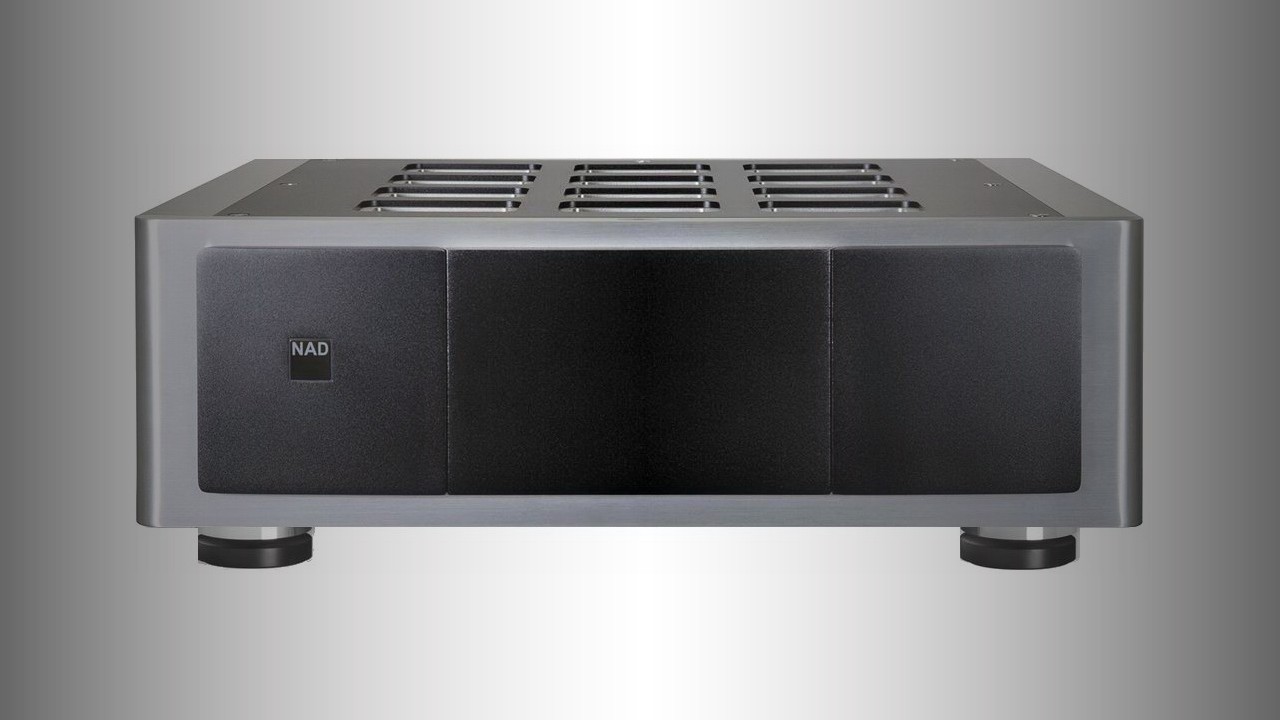The NAD M28 is the company’s latest seven-channel Class D power amplifier, replacing the existing NAD M27. The new amplifier is externally identical to its predecessor, but is very different in internal design. The M28 combines NAD’s hybrid switching (Class D) circuitry with Purifi’s Eigentakt amplifier technology to deliver more refined sound with increased dynamic range, as well as higher power output.
The power of the new amplifier has indeed increased significantly and NAD claims that the NAD M28 can deliver 200 W/8 ohms per channel with all seven channels running, and its dynamic (peak) indicator can even reach 320 W. Connect the NAD M28 to 4-ohm speakers, and NAD says the M28 will deliver 340 watts to each of its seven simultaneous channels.
The NAD M28 looks identical to the earlier NAD M27 and is a stunning piece of industrial design for a machine in its class. The chassis is made of metal and has an attractive matte finish, and there are ventilation holes on the top panel (even Class D amps generate a bit of heat). The amplifier is equipped with four pointed feet, and NAD includes magnetic foot pads with this model in case you decide to install the NAD M28 on some “delicate” surface.
The amplifier’s front panel is a piece of minimalist elegance with a simple black finish and an illuminated NAD logo. The backlight color changes from white (operating mode) to yellow (standby mode) and to red if the protection is triggered due to a short circuit in the load. Instead of the usual button, a sensor is used to turn the device on/off, which is located on the top of the front panel. Perhaps my only complaint relates specifically to this sensor, since, firstly, it is difficult to find, and secondly, it responds slowly to touch and you cannot be sure whether the sensor has worked or not.
It would actually be better if the NAD logo doubled as an on/off button, but I guess I’m just being picky. Additionally, if you use the NAD M28 with an AV processor, you can simply use the 12V trigger input and then you won’t have to worry about turning the amp on and off manually. The NAD M28 has fairly compact dimensions of 435 x 156 x 380 mm (W x H x D) but weighs a hefty 21.2 kg. In terms of connections, the NAD M28 has seven RCA inputs and seven balanced XLR inputs. One or another connection is selected using toggle switches, and for each channel there is a mode indication on miniature LEDs. Under normal operating conditions of the amplifier they should be green, but if they turn red, it means overheating has occurred. Each amplifier channel is equipped with gold-plated output screw terminals. Also located on the rear panel is a trigger input, a button to control the brightness of the NAD logo, and a power switch.
An important advantage of the NAD M28 is its use of Class D amplification in combination with Purifi Eigentakt technology. Audiophiles often criticize Class D because they believe that this pulse technology robs amplifiers of some degree of audio fidelity. But class D amplifiers also have certain advantages, in particular, increased operating efficiency. The problem lies in the need to use filters at the output of amplifiers that would remove the noise created by class D devices due to their circuit design, and their potential negative impact on sound quality. The ideal solution would be to create an amplifier that combines the efficiency and output power of Class D with the musicality and transparency of Class A/B circuitry.
The Danish company Purifi offered its solution to this problem by developing the Eigentakt amplifier technology and eliminating the problems associated with the use of an output filter. In addition, the Eigentakt amplifier in signal limiting mode behaves almost as if operating in class A/B. While traditional Class D amplifiers can become unstable when overloaded, Eigentakt provides gentle clipping that is harmless to speakers. NAD has already used Eigentakt technology in its M33 Masters Series integrated amplifier, and now it has included it in the NAD M28 power amplifier. Besides efficiency and improved sound quality, another benefit of Class D amplifiers is increased output power. As mentioned, NAD claims the M28 can deliver 200W into 8 ohms and 340W into 4 ohms with all seven channels running simultaneously.
The NAD M28 is a smartly designed and attractive amplifier that proves that a modern Class D amplifier is capable of much more than you might imagine. Purifi Eigentakt technology provides pure and transparent sound energy transmitted with high precision. This amplifier is incredibly detailed, with a wide dynamic range and more output power than you’ll ever need. The NAD M28 isn’t cheap, but it’s a high-end model, so that’s to be expected. I also understand that some people may still prefer the sound of a more traditional amp, but this is an excellent powerhouse that will complement the NAD M17 V2i or any other high-end AV processor very well.
In fact, my only complaint is that NAD hasn’t taken the same modular approach with the NAD M28 as it has with other Masters series amps. The reality is that seven channels of audio may not be enough these days, and the NAD M17 processor, for example, has an 11-channel output. Therefore, it would be nice if you could increase the number of channels by adding modules as your system expands.
Characteristics of NAD M28
Number of channels: 7
Inputs: unbalanced RCA, balanced XLR
Output power: 7 x 200 W (8 Ohm), 7 x 340 W (4 Ohm)
Amplifier class: D, circuit design Purifi Eigentakt
Dimensions (W x H x D): 435 x 156 x 380 mm
Weight (kg): 21, 2 kg
